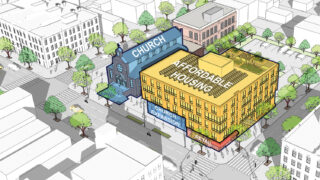
New Yorkers crave an opportunity to experience nature at just about any scale—from the vast lawns of Central Park’s Sheep Meadow to the plant shop that just restocked the replacement pothos we’ve been waiting for. The pandemic transformed our desire for outdoor space into a necessity. Outdoor terraces, plazas, and parks are in huge demand as new building projects are established. But architects in New York, and New Yorkers in general, know this: outdoor real estate comes at a premium. A simpler way that architects can provide urban dwellers access to nature at home and at the workplace is by incorporating interior landscapes.
Beyond the quantifiable improvements to air quality and general well-being, interior landscapes offer an experience greater than the sum of their parts. The difference between potted, decorative plants and a thoughtfully curated horticultural experience is significant. More than anything, careful planning, expertise, and a little bit of ingenuity can forge a new path toward interior gardens being as pleasurable as their traditional outdoor counterparts. This, in turn, will make our workplaces and our cities more livable.
Just as parks are natural gathering places, interior landscapes can bring people together. People want true connections to nature that are thoughtful, designed, and immersive. For these to be successful, we need to reject the old ways of thinking about indoor plants. Green walls offer only a two-dimensional gesture toward landscape. Green roofs satisfy an important part of efforts to reduce the heat island effect and storm runoff, but they’re only comfortable in certain seasons. These interventions, while crucial developments in building practices, leave us with an impression of nature stripped of its dynamic qualities. They are static and distant, proxies of nature devoid of real character and depth. Advances in LED technology and HVAC systems now allow for the careful calibration of interior environments, and the opportunity to merge human comfort with horticultural dynamics. With the careful selection of plant material, drainage, and watering techniques, there really is no limit to what is possible.
For example, in a project we call “The Enclosed Forest,” my studio, VERDANT, was fortunate to work with an ambitious and progressive client, whose focus was on quality of life for its employees. This garden functions more like a park than a landscape installation. At the time of the project’s design and construction, the idea of investing so much time and money in an indoor landscape felt risky. But in the intervening years, there have been surprising advances in technology (lighting, irrigation, etc.). We as designers have also learned from this process and are eager to take the next step in implementing that new tech, at this kind of scale.

What ultimately defines an experience with plants is sensorial: a mixture of temperature, light, humidity, scent, and movement. The dynamic nature of a garden is often forgotten in application, in favor of a kind of sanitized stasis, where the real life cycle of plants is covered up. If perfection is the goal, the result is something more clinical. People deserve landscapes that embrace the unexpected, and it’s okay if things get a little messy—that’s just the natural environment at work. In order for an interior landscape to convey natural beauty, we must reflect on what constitutes nature and, by extent, beauty. Is it the plants themselves that pull us in, or is it really the ebb and flow of something that is living and not staged?
Interior landscapes are one tool at our disposal that can be readily implemented, and can quickly raise the standard of just about any kind of interior space. So much of the metropolitan workforce is bound to a computer or desk. By collaborating with all the stakeholders and investing in a little more green space both indoors and out, we can collectively make more and more interior spaces that bring joy and uplift our everyday endeavors.
Joshua Gerber, AIA, is a senior project manager and designer at VERDANT, a landscape design-build studio based in Brooklyn. Drawing on his passions for historic buildings and New York history, he appreciates any opportunity to blend architectural ingenuity with the natural environment.























